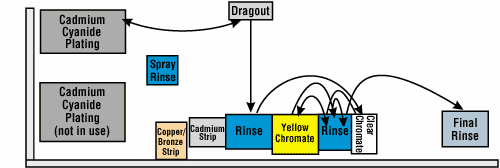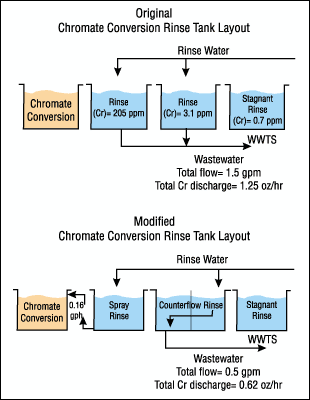Improving Process Efficiency
Modifying tank layouts improves plating efficiency...
Share
The layout of finishing process and rinse tanks plays an important role in overall process efficiency as well as in waste generation. At most finishing facilities, process lines evolve as tanks are added, removed or become obsolete because of production demands and development of new process chemistries. Over time, process changes can result in inefficient tank layouts that often limit or complicate many pollution prevention opportunities, particularly closed-loop recycling technologies.
Modifying tank layouts can significantly improve raw material use, water use and throughput; reduce waste generation; and facilitate application of chemical recovery technologies.
All Metals Processing Co., Burbank, CA, performs cadmium, bronze and zinc electroplating and black oxide coating for aerospace and other industrial customers. All Metals employs 15, and its facility has about 8,000-sq-ft for plating operations.
All Metals uses about 7,800 gal of water daily, most of which is used for rinsing operations. Cyanide and metal-bearing wastewater flows from rinse tanks to the on-site wastewater treatment system (WWTS). In addition, dragout and water from rinse tanks that spills onto the floor, drains to a sump from which they are pumped to the WWTS. The WWTS currently generates about 680 lb of filter cake per month, which is disposed of at an off-site hazardous waste landfill. Treated wastewater is discharged to the POTW.
At the beginning of the project, All Metals’ goals were to reduce water use and eliminate wastewater discharges by installing chemical recovery systems. In cooperation with the Merit Partnership (see sidebar), All Metals agreed to evaluate its process tank layout in order to reduce the contaminant load and wastewater flow from rinse operations before consulting with technology vendors.
Cadmium Line Original Layout
All Metals selected the cadmium electroplating line for a tank layout evaluation because it was the most frequently used process line and dragout from this line contributed the largest quantity of metals to the wastewater. The original cadmium electroplating line layout and workflow are shown in Figure 1.
After alkaline soak cleaning and acid etching, the cadmium electroplating line consists of the following three processes: 1) cadmium cyanide electroplating; 2) bright dip (chromic acid); and 3) chromate conversion. Each process bath is followed by one or more rinses.
Based on its evaluation, the original tank layout presented several problems:
- High dragout losses. Only one dragout tank and no spray rinses were used in the original tank layout to recover process solution dragout. Consequently, dragout was lost to single-stage rinses that discharged to the WWTS. Dragout was also lost to the floor because of large spaces between tanks.
- High rinse water use. The single-stage rinses required a high rinse-water flow rate to maintain adequate rinse quality.
- Inefficient workflow. Workflow overlap and backtracking increased worker fatigue, decreased process throughput and contributed to dragout loss.
- Process solution mixing in a shared rinse tank. A shared rinse tank resulted in process solutions from two operations mixing in the rinse tank, which negatively impacted rinse quality and prohibited potential recovery and recycling of the process solutions.
Cadmium Line Modified Layout
A computer program called Perfect Rinsing was used to model the effects of adding tanks to the cadmium electroplating line and changing tank configurations, estimate the benefits of these changes and determine the preferred layout. The computer program, designed by Finishing Technology, simulates rinsing operations. Specifically, the program computes key rinsing parameters, including concentrations of process chemicals in the rinse tank and the process chemical discharge rate based on the input parameters such as the dragout rate, process bath chemical concentration and evaporation rate, rinse-water flow rate and number and configuration of rinse tanks. The dragout rate on the cadmium electroplating line was determined by measuring the increase in the metal concentration in the rinse tank for each rack of parts plated. The computer program assumes complete mixing and steady state conditions of water in the rinse tank.
Several alternative rinse tank configurations were developed by changing the type and number of rinse tanks and rinse-water flow rates. Comparisons were made of the total rinse-water flow rates, the total dragout losses and the rinse water quality in the rinse tanks of the original and alternate configurations. With allowance for the physical constraints at All Metals, such as available floor space and the nature of the production processes, the preferred tank layout was selected. The selected tank layout modifications are shown in Figure 2.
Impact of Layout Modifications
The modified tank layout allowed All Metals to recover and re-use process solution dragout, reduce rinse-water flow, improve rinsing, implement more efficient workflow and lower effluent metal concentration.
The spray and dragout rinse tanks collect concentrated solutions that are used to replenish process baths. The spray rinse tanks added after the cadmium cyanide plating and chromate conversion tanks are expected to reduce process solution loss 50%. The sprays remove dragout left on parts before they reach the running rinses. The dragout is used to replenish the process baths.
Process solution recovery will also be improved because less dragout is expected to result in a 50% decrease in the quantity of WWTS filter cake generated by treating wastewater from the cadmium electroplating line.
| TABLE I—Tank Layout Modification Results | |||
| Before Modification | After Modification |
Cost Savings | |
| Cadmium Cyanide Dragout Chromate Conversion Dragout Rinse Water Sewer Fee WWTS Chemicals WWTS Filter Cake |
18 gal/mo 123 gal/mo 31,700 gal/mo 31,700 gal/mo 200 lb/mo |
9 gal/mo* 62 gal/mo* 15,800 gal/mo 15,800 gal/mo Not Quantified 100 lb/mo |
$400/yr $180/yr $360/yr $1,440/yr $240/yr |
| Total Cost Savings = $2,620/yr Total Cost = $4,520 Payback Period = 1.73 years |
|||
| *Estimated from Perfect Rinsing results | |||
Reduced rinse-water flow. All Metals significantly reduced rinse-water flow by installing counterflow rinse tanks. Two-stage counterflow rinses theoretically require 97% less water than single-stage rinses to achieve comparable rinse quality. Spray rinses and dragout tanks reduce the total rinse-water flow required for effective rinsing. Although the computer program results indicated that flow rates of less than 0.25 gpm could be used for the counterflow rinses, All Metals conservatively installed 0.5 gpm flow restrictors on its three rinse tanks in place of the 1.5 gpm flow restrictors originally used on the two rinse tanks of the original layout. The combined reduction in dragout and rinse-water flow reduces the quantities of wastewater treatment chemicals used.
Improved rinsing. As shown in Figure 3, the concentration of cadmium in the last cadmium cyanide rinse tank is estimated to have decreased 99%, which resulted in a dramatic increase in rinsing quality. Such a change improves overall process efficiency, reduces the numbers of reject parts and reduces dragin to other process baths.
More efficient workflow. Repositioning the tanks decreased the amount of worker time and effort required to move parts through the cadmium electroplating line. Consequently, All Metals has the capacity for increased process throughput.
Lower concentration of metals in WWTS discharge. The concentrations of cadmium and chromium discharged from the WWTS to the POTW are expected to decrease because of dragout reduction and process chemical recovery. This will help All Metals consistently meet its cadmium and chromium discharge limits. This will result in cost savings by reducing paperwork and potential permit violations.
Costs
The capital costs for the tank layout modifications included $2,000 for two used counterflow rinse tanks and $600 for two new spray rinse tanks. Costs for ancillary materials such as plumbing hardware were not recorded; however, these costs were not significant. Therefore, the total capital costs for the tank layout modification was $2,600. Modifications were performed by three shop workers in about 8 days, and the total labor cost for modifying the layout was $1,920.
| Table II—Chemical Recovery System Design Parameters | ||
| Before Modification |
After Modification |
|
| Cadmium Loading Chromium Loading Wastewater Flow Rate |
0.04 oz/hr 1.25 oz/hr 3.0 gpm |
0.02 oz/hr 0.62 oz/hr 1.0 gpm |
| Dragout and wastewater flow reductions resulting from tank layout modifications will enable All Metals to purchase a smaller chemical recovery system, which will require less capital costs. | ||
The Next Step
By reducing dragout and rinse-water flow rates through tank layout modifications, finishing facilities can cost effectively apply chemical recovery technologies. By modifying its tank layout of the cadmium electroplating line, All Metals reduced dragout and rinse water use at the point of generation, segregated rinses and maximized production efficiency. All Metals is now evaluating technologies to recover process chemicals from wastewater for re-use in the process tanks. In addition, these technologies usually generate clean water that can be recycled into the rinse tank for re-use. Potential chemical recovery technologies include reverse osmosis, ion exchange, vacuum evaporation and electrowinning.
What is the Merit Partnership?
The Merit Partnership is a joint venture between U.S. EPA Region 9, state and local regulatory agencies, private sector industries and community representatives created to promote pollution prevention, identify pollution prevention technology needs and accelerate pollution prevention technology transfer within various industries in southern California. The project is funded by the Environmental Technology Initiative and EPA Region 9, and is implemented in part through the National Institute of Standards and Technology with the California Manufacturing Technology Center.
Related Content
Technical Talks Educate Industry in Wastewater Treatment
SUR/FIN 2025: Brenntag promotes its ability to work closely with customers for wastewater facilitation through educational presentations.
Read MoreExperts Team Up to Highlight Surface Finishing, Wastewater Solutions
SUR/FIN 2025: Hubbard-Hall and industry partners invite attendees over to learn about different product/technology offerings for surface cleaning, plating and wastewater treatment.
Read MoreCeramic Media Filters Out Metals for Less
A low-cost alternative to legacy technologies, this ceramic molecular media filtration system removes metals and pollutants from industrial wastewaters at a low price point.
Read MoreNASF/AESF Foundation Research Project #120: Electrochemical Destruction of Perfluorooctanesulfonate in Electroplating Wastewaters – January – December 2023
This NASF-AESF Foundation research project report covers quarterly reporting for the year 2023 at the University of Illinois at Chicago. The objective of this work is to utilize a cost-effective reactive electrochemical membrane (REM) for the removal of PFAS from synthetic electroplating wastewater. Discussed here are the oxidation of PFOA with three different catalysts, development of a method for detecting PFAS, as well as work on 6:2-fluorotelomersulfonic acid (6:2 FTS) and electrodeposited bismuth/tin oxide catalysts.
Read MoreRead Next
The Best Tape for High-Temperature Applications
High-temperature tapes are designed with maximum heat ratings indicating the highest temperature they can withstand for a very short time.
Read MoreDelivering Increased Benefits to Greenhouse Films
Baystar's Borstar technology is helping customers deliver better, more reliable production methods to greenhouse agriculture.
Read MoreAlkaline Cleaning Guide
Gregg Sanko, Senior Chemist, Oakite Products, Inc. provides an overview of the alkaline cleaning process.
Read More

























